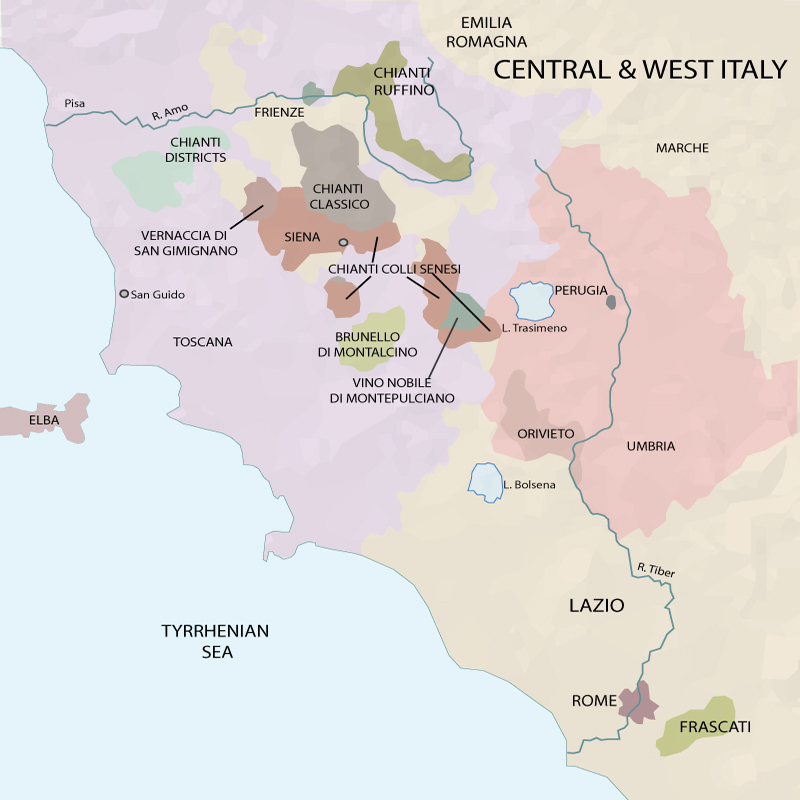The Wines of Tuscany
Tuscany (Toscana) is the quintessential image we all have of Italian wine country – rolling hills, olive trees, umbrella pines and of corse, vines, lots of vines. Tuscany is the 4th most planted region in Italy with x ha of vines.
[jwplayer player=”1″ mediaid=”30316″]
Climate and Geography – Warm Continental to Mediterranean
Soils – Limestone, marl
Grapes – Sangiovese,
Viticulture – ?
Vinification – Don’t know
Top producers – Banfi,
Regions of Northeast Italy

TOSCANA
Chianti DOC –
Chianti Classico DOCG –
Chianti Rufina –
Brunello di Montalcino DOCG –
Rosso di Montapulciano DOC and Rosso di Montalcino DOC –
Vernaccia di San Gimigano DOCG –
Bolgheri DOC –
Toscana IGT –
Carmignano DOCG –
Vin Santo –
History of Tuscan wines
Tuscany was also the economic, political, and cultural center of Italy for many centuries including Medieval times with few small landholders but mostly the wealthy landowners or monestaries. The 14th century represented the height of the wine trade in Tuscany with families like the Frescobaldis, Ricasolis, and the Antinoris becoming established wine producers. In the 1950s this system of noble landowners with sharecroppers working the land came to an end and the vineyards and wine took a downturn. Begining in the 1980s investors from other parts of Italy and foreigners invested in the region and modernized the faciliites and vineyards moving aways from some of the tradtional winemaking and introducing international varietals. Recently, there has been a return to tradition but many of the gains in quality from the international investment have been retained giving us the best of both worlds.
Geography
68% of Tuscany is classified as hilly and teh elevation of plantings varies from near sea level on the coast at Maremma to elevations up to 500 meters. A high diurnal range in the most famous hilly regions of Tuscany contribute to the quality of wines.
Classificatinos – 48 DOCs and DOCGs in 2014 – producers often chose to use the IGT “Toscana” to avoid the restrictions.
About 50% of Tuscany’s 60,000ha of vines are classified as DOC or DOCG.
Chianti Classico – up to 20% non-Sangiovese allowed
Brunello di Montalcino – 100% Sangiovese
Vino Noble di Montapulciano – 30%in 2010 to allow up to 30% other grapes are allowed in Chianti which is often blended with Merlot to make the wine more approachable in youth.
Grapes:
Sangiovese –
International Varieties – Super tuscan trend and still rules changed to allow some international varieites
Bolgheri – has its own DOC, Sassica (also has its own DOC) near the coast this is “supertuscan” central and home to the vineyards supplying the grapes for Sassicaia, Masseto, Ornallia, Solera,… (I think) but Carmignano, Suvereto, and Cortona (Syrah) are also now international variety based.
Chianti – tangly dry red wines with chalky tannins, high acidity, cherry fruit but varying quality – It covers an area large enough to apply to 15,500 ha of vines and includes 7 sub-regions – Colli Fiorentini, Chianti Rufina, Chianti Montalbano, Chianti Colli Senesi, Chianti Colline Pisane, Chianti Colli Aretini, and Chianti Montespertoli or the label can simly say Chianti
Grapes in the Wines of Tuscany
Sangiovese – The
Trebbiano Toscana – The
Canaiolo Nero – The
Malvasia Bianca Lunga–
Merlot –
Cabernet Sauvignon – x
Vernaccia di San Gimignano –
Merlot –
Key People and Wines of Tuscany
Biondi Santi – In 1865, Ferruccio Biondi-Santi identified a variant of Sangiovese through mass selection know as as ‘Brunello” (meaning “the brown one” because of the color of it’s skin at harvest) and is now known to be the Sangiovese Grosso grape that had first been identified by Clemente Santi in 1842. These grapes, when grown in the 8000 ha surrounding he fortified town of Montalcino have thick skins and create a tannic wine with a brown hue.
Ferruccio’s son, Tancredi founded the Montalcino’s first co-operative during the economic depression of the 1920s
one”now called Sangiovese Grosso) that is resistant Powdery Mildew. Family that changed the wines of Montalcino from sweet sparkling whites to powerful reds known as Brunello di Montalcino based on the Sangiovese grape.
Top Wines
Gaja wines are….
Tasting Profile
| Chianti (Sangiovese) | Barolo/ Barbaresco (Nebbiolo) | Barbera d'Asti (Barbera) | Dolcetto | Gavi (Cortese) | Tuscan IGT | Pinot Gris | |
|---|---|---|---|---|---|---|---|
| Appearance | |||||||
| Color | Ruby | Garnet (Orange rim) | Ruby/Purple | Ruby/Purple | Lemon-Green | ||
| Intensity | Medium | Medium | Medium + | Medium + | Medium | ||
| Nose | |||||||
| Intensity | Medium + | Medium + | Medium | Medium + | Medium + | Medium | |
| Fruit | Cherry | Cherry | Cherry | ? | |||
| Earth | Chalk | Tar | Minimal | Minimal | |||
| Wood | Miminal | Varies | Varies | Varies | no Oak | ||
| Other | Oxidative | Roses, Oxidative | Oxidative | Oxidative | |||
| Palate | |||||||
| Sweetness | Dry | Dry | Dry | Dry | Dry | Dry | |
| Acidity | Medium + | Medium + | High | Medium - | Medium + | ||
| Tannins | Medium + (Chalky) | HIgh | Medium - | High | |||
| Phenolics | None | None | None | None | |||
| Alcohol | Medium | Medium | Medium | Medium |





